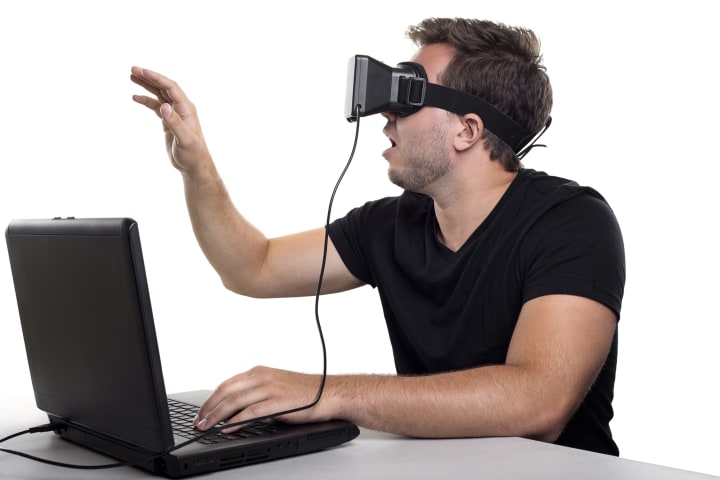Main Causes of VR Simulation Sickness and Ways to Avoid It
The high cost isn’t all that can keep gamers from making the jump into VR. A good percentage of people have gotten sick from using it.

VR has become popular among gamers since it was first introduced because it gives them a more immersive playing experience, and there is a plethora of choices from which they can choose. While it’s not in everyone’s price range, VR can make you feel as if you’re in the game itself. As a lifelong gamer, the idea is exciting, but the hefty price tag is enough to bring me back to my senses. I would also need to have a beast of a PC to run it.
The high cost isn’t all that can keep gamers from making the jump into VR. A good percentage of people have gotten sick from using it. Not only have they been left with a sizable hole in their cash flow, but they have also been spending more time leaning over a toilet than killing cyborgs inside a virtual world. You might be a in that same situation, and you might think that you can wait it out and hope that it will pass. If you’re one of the 25% who are prone to motion sickness, getting that nauseating feeling every time you slip on a VR headset is most likely inevitable.
Causes of VR Simulation Sickness

Stock Photo from DepositPhotos.com
Almost everyone has heard of motion sickness. You experience turbulence on a flight, and you start to feel like you’re about to wear that egg sandwich you had for breakfast. Studies have shown that 25% of people will get the symptoms of motion sickness when they fly, and a good percentage of them will throw up.
Nausea and vomiting are the most common symptoms of motion sickness, but people can experience the following symptoms as well:
- Sweating
- Increased salivation
- Feeling warm
- Dizziness
- Drowsiness
- Headache
- Loss of appetite
- Less sensitivity to certain odors
Motion sickness is caused by certain visual clues that conflict with what your body is feeling, and it can cause a loss of equilibrium.
VR simulation sickness is similar, but it works in reverse. When you’re on a moving plane, your eyes are telling you that you are stationary, but your body tells you that you’re moving. VR simulation sickness is caused by the same combination of stimuli, but it’s the other way around. Your eyes tell you that you’re moving, but your body tells you that you’re stationary.
Both conditions are caused by a sensory conflict that can throw you off balance. As you move into the VR system, your body stays in the same location, and the system may not process the movements as well as it needs to. The system lag can cause someone to get sick, and it’s one of the most common reasons why people get this condition.
People have also experienced eye strain when they use a VR system, because our eyes have to move in at a slight angle to compensate for the narrower field of vision. Not only can it cause your eyes to strain, but it can also cause you to vomit. Your eyes know that there’s a screen right in front of them, but there’s a scenery that appears to be a good distance away. The visual mismatch could be the reason why so many people experience this symptom while they’re using VR.
There are a number of reasons why people get sick from VR, but it’s largely because of evolution. There could be a mechanism in our bodies that makes sure we don’t die from toxic chemicals to which we might have been exposed. Your body might think that you’ve ingested something harmful, so it takes steps to get rid of it. No matter what you believe in, you can blame your higher power for causing that vomit-fest every time you put on your VR headset.
Why Some People are More Susceptible Than Others

Stock Photo from DepositPhotos.com
There’s no single reason why some people are more prone to this condition, but two of the biggest factors are gender and age. Women are more likely to get motion sickness, and they’re more likely to vomit as well. Studies have shown that for every man who gets it, there are four women who do. And they’re not just more susceptible to this kind of illness. They can experience stronger symptoms.
No one knows why there’s such a massive gap between men and women, but it could be related to the female hormonal cycle. Women are also more likely to get this condition while they’re in their menstrual cycle. So, if you’re a woman, you might want to lay off the VR during “that time of the month.”
A person’s age can be a major factor as well. Susceptibility to motion sickness usually starts when someone is six or seven years old, and it reaches its peak at nine. Susceptibility can start to decline when someone goes through puberty, and it can return at age 20. Everyone is different, so it can be hard to say for sure what will happen as a person ages. People who suffer from migraines, inner ear conditions, and vision problems are more susceptible to motion sickness. So, if you have experienced any of those conditions, you should think twice about making the jump into VR.
How to Reduce the Symptoms of VR Simulation Sickness

Stock Photo from DepositPhotos.com
There’s no way you can prevent VR simulation sickness from happening, but there are certain steps you can take to reduce the symptoms. Research is being done on why this condition occurs, but low frame rates can be a contributing factor. You should never play through anything that has less than optimal performance, so it’s best to restart the game if it’s glitching or appears choppy. That way, you don’t put yourself in a situation that can make you sick.
You should consider sitting down, because it can give you some sense of stability while you’re playing a game in VR. Put yourself in a comfortable position that’s at least a couple of feet away from the camera so you can get a clear field of vision. You also might want to take some ginger supplements because they have been proven to help with motion sickness, and the same can be true with VR-related illnesses.
You can get ginger supplements in a variety of ways, but you want to make sure you follow the directions precisely. You can also get over-the-counter medications to help you with the symptoms, but you should talk to your doctor before you start taking them. Acupressure wristbands can be used to help you with the symptoms, because it’s a less invasive way to get some relief.
Studies have shown that motion sickness is related to perceptual problems related to the inner ear. So, it’s not a good idea to use your VR headset when you have an ear infection, and the same can be true if you have a cold or any other condition that can affect your ears. You may experience some discomfort during your VR experience, and it could make you feel worse than you already are.
Certain reports have suggested that VR simulation sickness is related to what military personnel experience when they’re in a simulated environment, and some people are able to adapt to it through gradual acclimation. You may get used to it over time, so you shouldn’t give up the first time you get sick. Try easing yourself in by going through it multiple times, and move slowly through the environment so your body has time to adjust. You could build up a tolerance the more you play, but it won’t work for everyone.
You always want to make sure your headset is properly adjusted so the display is visible, because you could experience some discomfort if it’s in a slightly off position. The most obvious solution is to stop playing the moment you feel sick. If you feel sweaty or start to feel a headache coming on, you won’t be able to play through it because the symptoms will get worse.
If you decide to push yourself through the discomfort, you could put yourself out of commission for days. You may not be able to drive to work, and you could experience some other problems over the long term. You could become carsick, and you could even become ill while playing non-VR games. Stop playing, get up slowly, and don’t play again until you’ve fully recovered.
Final Thoughts

Stock Photo from DepositPhotos.com
VR simulation sickness won’t affect everyone, but the symptoms can be recognizable. It’s the same kind of discomfort that people feel when they’re on a turbulent flight or on a boat that’s rocking back and forth. The good thing about VR is that you have some control about when to shut it off, but you don’t want to push yourself too far.
If you can recognize the warning signs and be mindful of the symptoms, you can reduce your susceptibility to this uncomfortable condition, and you might be able to eliminate it altogether. Don’t think that it’s all in your head, because there’s a scientific reason for what’s going on. If your body is telling you that it doesn’t feel well, you need to take certain steps to keep yourself from getting worse.
Sources
About the Creator
John Grgurich
John Grgurich is a freelance writer, YouTuber, and blogger who has spent the last two years writing online content for several companies. He has been gaming most of life, and he’s played classics like Super Mario Brothers and Duck Hunt.






Comments
There are no comments for this story
Be the first to respond and start the conversation.